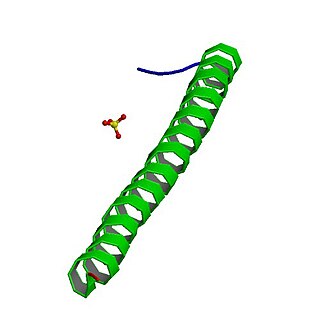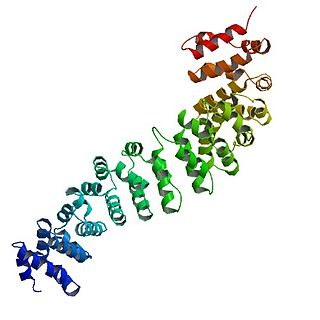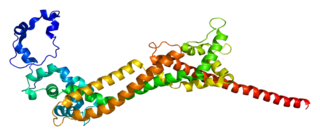
Paracrine signaling is a form of cell signaling, a type of cellular communication in which a cell produces a signal to induce changes in nearby cells, altering the behaviour of those cells. Signaling molecules known as paracrine factors diffuse over a relatively short distance, as opposed to cell signaling by endocrine factors, hormones which travel considerably longer distances via the circulatory system; juxtacrine interactions; and autocrine signaling. Cells that produce paracrine factors secrete them into the immediate extracellular environment. Factors then travel to nearby cells in which the gradient of factor received determines the outcome. However, the exact distance that paracrine factors can travel is not certain.
The Wnt signaling pathways are a group of signal transduction pathways which begin with proteins that pass signals into a cell through cell surface receptors. The name Wnt is a portmanteau created from the names Wingless and Int-1. Wnt signaling pathways use either nearby cell-cell communication (paracrine) or same-cell communication (autocrine). They are highly evolutionarily conserved in animals, which means they are similar across animal species from fruit flies to humans.

Catenins are a family of proteins found in complexes with cadherin cell adhesion molecules of animal cells. The first two catenins that were identified became known as α-catenin and β-catenin. α-Catenin can bind to β-catenin and can also bind filamentous actin (F-actin). β-Catenin binds directly to the cytoplasmic tail of classical cadherins. Additional catenins such as γ-catenin and δ-catenin have been identified. The name "catenin" was originally selected because it was suspected that catenins might link cadherins to the cytoskeleton.

Adenomatous polyposis coli (APC) also known as deleted in polyposis 2.5 (DP2.5) is a protein that in humans is encoded by the APC gene. The APC protein is a negative regulator that controls beta-catenin concentrations and interacts with E-cadherin, which are involved in cell adhesion. Mutations in the APC gene may result in colorectal cancer.

Catenin beta-1, also known as beta-catenin (β-catenin), is a protein that in humans is encoded by the CTNNB1 gene.

Alpha-catenin functions as the primary protein link between cadherins and the actin cytoskeleton. It has been reported that the actin binding proteins vinculin and alpha-actinin can bind to alpha-catenin. It has been suggested that alpha-catenin does not bind with high affinity to both actin filaments and the E-cadherin-beta-catenin complex at the same time. It has been observed that when alpha-catenin is not in a molecular complex with beta-catenin, it dimerizes and functions to regulate actin filament assembly, possibly by competing with Arp2/3 protein. Alpha catenin exhibits significant protein dynamics. However, a protein complex including a cadherin, actin, beta-catenin and alpha-catenin has not been isolated.

Axin-1 is a protein that in humans is encoded by the AXIN1 gene.

Lymphoid enhancer-binding factor 1 (LEF1) is a protein that in humans is encoded by the LEF1 gene. It's a member of T cell factor/lymphoid enhancer factor (TCF/LEF) family.

Segment polarity protein dishevelled homolog DVL-1 is a protein that in humans is encoded by the DVL1 gene.

Secreted frizzled-related protein 1, also known as SFRP1, is a protein which in humans is encoded by the SFRP1 gene.

Segment polarity protein dishevelled homolog DVL-2 is a protein that in humans is encoded by the DVL2 gene.

Segment polarity protein dishevelled homolog DVL-3 is a protein that in humans is encoded by the DVL3 gene.

Disheveled-associated activator of morphogenesis 1 is a protein that in humans is encoded by the DAAM1 gene. Evidence of alternative splicing has been observed for this gene but the full-length nature of these variants has not been determined.

Planar Cell Polarity (PCP) is the protein mediated signaling that coordinates the orientation of cells in a layer of epithelial tissue. In vertebrates, examples of mature PCP oriented tissue are the stereo-cilia bundles in the inner ear, motile cilia of the epithelium, and cell motility in epidermal wound healing. Additionally, PCP is known to be crucial to major developmental time points including coordinating convergent extension during gastrulation and coordinating cell behavior for neural tube closure. Cells orient themselves and their neighbors by establishing asymmetric expression of PCP components on opposing cell members within cells to establish and maintain the directionality of the cells. Some of these PCP components are transmembrane proteins which can proliferate the orientation signal to the surrounding cells.

CXXC-type zinc finger protein 5 is a protein that is encoded by the CXXC5 gene in humans.

Dishevelled (Dsh) is a family of proteins involved in canonical and non-canonical Wnt signalling pathways. Dsh is a cytoplasmic phosphoprotein that acts directly downstream of frizzled receptors. It takes its name from its initial discovery in flies, where a mutation in the dishevelled gene was observed to cause improper orientation of body and wing hairs. There are vertebrate homologs in zebrafish, Xenopus (Xdsh), mice and humans. Dsh relays complex Wnt signals in tissues and cells, in normal and abnormal contexts. It is thought to interact with the SPATS1 protein when regulating the Wnt Signalling pathway.
Naked cuticle 1 (NKD1) is a human gene that encodes the protein Nkd1, a member of the Naked cuticle (Nkd) family of proteins that regulate the Wnt signaling pathway. Insects typically have a single Nkd gene, whereas there are two Nkd genes, Nkd1 and Nkd2, in most vertebrates studied to date. Nkd1 binds to the Dishevelled (Dvl) family of proteins. Specific truncating NKD1 mutations identified in DNA mismatch repair deficient colon cancer that disrupt Nkd1/Dvl binding implicate these mutations as a cause of increased Wnt signaling in approximately 1% of human colon cancer, the majority of which have increased Wnt signaling due to mutations the adenomatous polyposis coli (APC), AXIN2, or rarely the beta-catenin genes.
Naked cuticle (Nkd) is a conserved family of intracellular proteins encoded in most animal genomes. The original mutants were discovered by 1995 Nobel laureates Christiane Nüsslein-Volhard and Eric F. Wieschaus and colleagues in their genetic screens for pattern-formation mutants in the fruit fly Drosophila melanogaster. The Nkd gene family was first cloned in the laboratory of Matthew P. Scott. Like many cleverly named fly mutants, the name "naked cuticle" derives from the fact that mutants lack most of the hair-like protrusions from their ventral cuticle and thus appear "naked".

In molecular biology, the DEP domain is a globular protein domain of about 80 amino acids that is found in over 50 proteins involved in G-protein signalling pathways. It was named after the three proteins it was initially found in:

Dishevelled binding antagonist of beta catenin 1 is a protein that in humans is encoded by the DACT1 gene. Dact1 was originally described in 2002 as a negative regulator of Wnt signaling by binding and destabilizing Dishevelled. More recent investigation into the molecular function of Dact1 has identified its principle role in the cell as a scaffold to generate membrane-less biomolecular condensates through liquid-liquid phase separation. Mutations in the phase-separating regions of Dact1 lead to Townes-Brock Syndrome 2 while its overexpression is associated with bone metastasis.